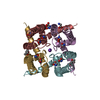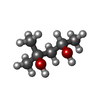+ データを開く
データを開く
- 基本情報
基本情報
| 登録情報 | データベース: PDB / ID: 6cpv | ||||||
|---|---|---|---|---|---|---|---|
| タイトル | MicroED structure of NaK ion channel reveals a process of Na+ partition into the selectivity filter | ||||||
 要素 要素 | Potassium channel protein | ||||||
 キーワード キーワード | TRANSPORT PROTEIN / ion channel / NaK | ||||||
| 機能・相同性 |  機能・相同性情報 機能・相同性情報 | ||||||
| 生物種 |  | ||||||
| 手法 | 電子線結晶学 /  分子置換 / クライオ電子顕微鏡法 / 解像度: 2.5002 Å 分子置換 / クライオ電子顕微鏡法 / 解像度: 2.5002 Å | ||||||
 データ登録者 データ登録者 | Liu, S. / Gonen, T. | ||||||
| 資金援助 |  米国, 1件 米国, 1件
| ||||||
 引用 引用 |  ジャーナル: Commun Biol / 年: 2018 ジャーナル: Commun Biol / 年: 2018タイトル: MicroED structure of the NaK ion channel reveals a Na partition process into the selectivity filter. 著者: Shian Liu / Tamir Gonen /  要旨: Sodium (Na) is a ubiquitous and important inorganic salt mediating many critical biological processes such as neuronal excitation, signaling, and facilitation of various transporters. The hydration ...Sodium (Na) is a ubiquitous and important inorganic salt mediating many critical biological processes such as neuronal excitation, signaling, and facilitation of various transporters. The hydration states of Na are proposed to play critical roles in determining the conductance and the selectivity of Na channels, yet they are rarely captured by conventional structural biology means. Here we use the emerging cryo-electron microscopy (cryoEM) method micro-electron diffraction (MicroED) to study the structure of a prototypical tetrameric Na-conducting channel, NaK, to 2.5 Å resolution from nano-crystals. Two new conformations at the external site of NaK are identified, allowing us to visualize a partially hydrated Na ion at the entrance of the channel pore. A process of dilation coupled with Na movement is identified leading to valuable insights into the mechanism of ion conduction and gating. This study lays the ground work for future studies using MicroED in membrane protein biophysics. | ||||||
| 履歴 |
|
- 構造の表示
構造の表示
| ムービー |
 ムービービューア ムービービューア |
|---|---|
| 構造ビューア | 分子:  Molmil Molmil Jmol/JSmol Jmol/JSmol |
- ダウンロードとリンク
ダウンロードとリンク
- ダウンロード
ダウンロード
| PDBx/mmCIF形式 |  6cpv.cif.gz 6cpv.cif.gz | 52.2 KB | 表示 |  PDBx/mmCIF形式 PDBx/mmCIF形式 |
|---|---|---|---|---|
| PDB形式 |  pdb6cpv.ent.gz pdb6cpv.ent.gz | 35.2 KB | 表示 |  PDB形式 PDB形式 |
| PDBx/mmJSON形式 |  6cpv.json.gz 6cpv.json.gz | ツリー表示 |  PDBx/mmJSON形式 PDBx/mmJSON形式 | |
| その他 |  その他のダウンロード その他のダウンロード |
-検証レポート
| 文書・要旨 |  6cpv_validation.pdf.gz 6cpv_validation.pdf.gz | 831.8 KB | 表示 |  wwPDB検証レポート wwPDB検証レポート |
|---|---|---|---|---|
| 文書・詳細版 |  6cpv_full_validation.pdf.gz 6cpv_full_validation.pdf.gz | 834.8 KB | 表示 | |
| XML形式データ |  6cpv_validation.xml.gz 6cpv_validation.xml.gz | 11.7 KB | 表示 | |
| CIF形式データ |  6cpv_validation.cif.gz 6cpv_validation.cif.gz | 15.7 KB | 表示 | |
| アーカイブディレクトリ |  https://data.pdbj.org/pub/pdb/validation_reports/cp/6cpv https://data.pdbj.org/pub/pdb/validation_reports/cp/6cpv ftp://data.pdbj.org/pub/pdb/validation_reports/cp/6cpv ftp://data.pdbj.org/pub/pdb/validation_reports/cp/6cpv | HTTPS FTP |
-関連構造データ
- リンク
リンク
- 集合体
集合体
| 登録構造単位 | 
| |||||||||||||||||||||||||||||||||||||||
|---|---|---|---|---|---|---|---|---|---|---|---|---|---|---|---|---|---|---|---|---|---|---|---|---|---|---|---|---|---|---|---|---|---|---|---|---|---|---|---|---|
| 1 | 
| |||||||||||||||||||||||||||||||||||||||
| 2 | 
| |||||||||||||||||||||||||||||||||||||||
| 単位格子 |
| |||||||||||||||||||||||||||||||||||||||
| Components on special symmetry positions |
|
- 要素
要素
| #1: タンパク質 | 分子量: 10706.538 Da / 分子数: 2 / 断片: UNP residues 19-110 / 由来タイプ: 組換発現 / 由来: (組換発現)  遺伝子: A9485_19160, B4155_3291, BACERE00184_02078, CN419_22740, CN950_06075, CN980_22870, COI98_17615, COK18_26145, CON37_12595 発現宿主:  #2: 化合物 | ChemComp-NA / #3: 化合物 | ChemComp-MPD / ( | #4: 水 | ChemComp-HOH / | |
|---|
-実験情報
-実験
| 実験 | 手法: 電子線結晶学 |
|---|---|
| EM実験 | 試料の集合状態: 3D ARRAY / 3次元再構成法: 電子線結晶学 |
- 試料調製
試料調製
| 構成要素 | 名称: NaK / タイプ: COMPLEX / Entity ID: #1-#2 / 由来: RECOMBINANT |
|---|---|
| 由来(天然) | 生物種:  |
| 由来(組換発現) | 生物種:  |
| 緩衝液 | pH: 7 |
| 試料 | 包埋: NO / シャドウイング: NO / 染色: NO / 凍結: YES |
| 急速凍結 | 凍結剤: ETHANE |
-データ収集
| 実験機器 |  モデル: Tecnai F20 / 画像提供: FEI Company |
|---|---|
| 顕微鏡 | モデル: FEI TECNAI F20 |
| 電子銃 | 電子線源:  FIELD EMISSION GUN / 加速電圧: 200 kV / 照射モード: FLOOD BEAM FIELD EMISSION GUN / 加速電圧: 200 kV / 照射モード: FLOOD BEAM |
| 電子レンズ | モード: DIFFRACTION |
| 撮影 | 電子線照射量: 0.1 e/Å2 フィルム・検出器のモデル: TVIPS TEMCAM-F416 (4k x 4k) |
| EM回折 | カメラ長: 1750 mm |
| EM回折 シェル | 解像度: 2.5002→3.1486 Å / フーリエ空間範囲: 0.76 % / 多重度: 4.1 / 構造因子数: 2685 / 位相残差: 22.68 ° |
| EM回折 統計 | フーリエ空間範囲: 81.7 % / 再高解像度: 2.5002 Å / 測定した強度の数: 27479 / 構造因子数: 5643 / 位相誤差: 20.27 ° / 位相残差: 20.27 ° / 位相誤差の除外基準: 0 / Rmerge: 0.206 / Rsym: 0.206 |
- 解析
解析
| ソフトウェア |
| ||||||||||||||||||||||||
|---|---|---|---|---|---|---|---|---|---|---|---|---|---|---|---|---|---|---|---|---|---|---|---|---|---|
| EM 3D crystal entity | ∠α: 90 ° / ∠β: 90 ° / ∠γ: 90 ° / A: 68.0716 Å / B: 68.0716 Å / C: 89.3 Å / 空間群名: I4 / 空間群番号: 79 | ||||||||||||||||||||||||
| CTF補正 | タイプ: NONE | ||||||||||||||||||||||||
| 3次元再構成 | 解像度: 2.5002 Å / 解像度の算出法: DIFFRACTION PATTERN/LAYERLINES / 対称性のタイプ: 3D CRYSTAL | ||||||||||||||||||||||||
| 原子モデル構築 | B value: 41 | ||||||||||||||||||||||||
| 精密化 | 構造決定の手法:  分子置換 分子置換開始モデル: PDB entry 3E89 解像度: 2.5→21.992 Å / SU ML: 0.37 / 交差検証法: THROUGHOUT / σ(F): 1.41 / 位相誤差: 20.26
| ||||||||||||||||||||||||
| 溶媒の処理 | 減衰半径: 0.9 Å / VDWプローブ半径: 1.11 Å | ||||||||||||||||||||||||
| 拘束条件 |
| ||||||||||||||||||||||||
| LS精密化 シェル |
|
 ムービー
ムービー コントローラー
コントローラー















 PDBj
PDBj






